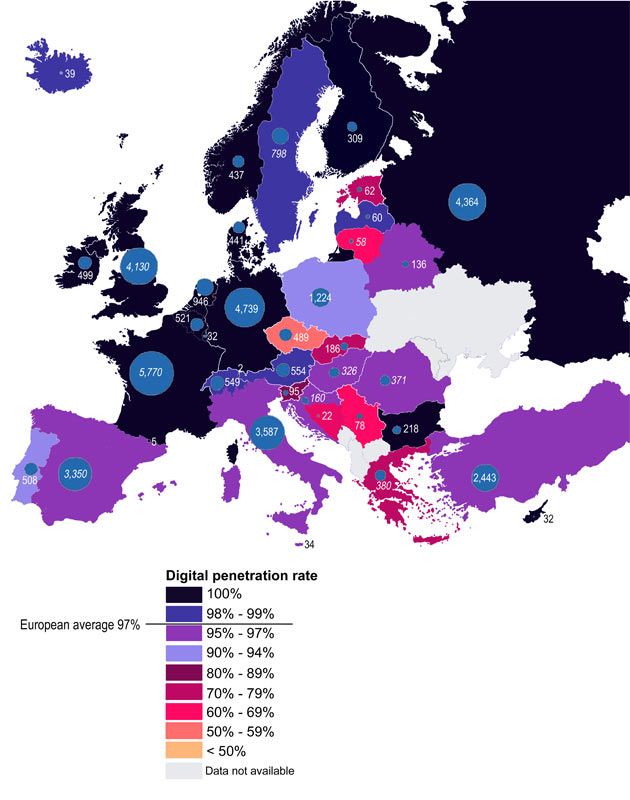Europe opened 2017 with 37,954 digital screens. With the addition of Bosnia-Herzegovina and its 22 digital theatres out of a total 34, MEDIA Salles now reports the technological development of 38 European cinemamarkets.
Launched in 2003/4, the years that the first thirty or so digital projectors in Europe date back to, the transition to the new projection technologies has now affected 97% of the Continent's screens, despite there still being countries where the penetration degree is below average*.
How much did the investment needed for this transformation amount to? Whilst awaiting the results of a deeper and more systematic study, it is nevertheless possible to estimate the entity of it. Taking an average cost - perhaps slightly conservative - of around fifty thousand euros for the projector and the server, it comes to approximately 2 billion euros. To this figure the cost of any work on adapting the projecting booths has to be added - in particular for air conditioning - as well as the extra equipment that makes it possible to broaden the offer to audiences, such as 3D and the satellite connection for live events. Not to mention the inevitable maintenance and service contracts or the higher electricity bills.
But even considering the basic cost "only", how many tickets correspond to the figure necessary for replacing the Old Continent's 35mm projectors? The average ticket price is 6.50 euros, with even marked differences, not only between Western and Central-Eastern Europe, but also within each macro-region. The price ranges from around 14 euros in Switzerland to a little over 5 in Portugal, with the 8.50/9 of the Netherlands, Germany, the United Kingdom and Austria in between. In Belarus, instead, you can go to the cinema for less than 2 euros, whilst in Malta it costs you 6 or in Cyprus over 7.
Instead, equipment costs are basically the same everywhere. Returning to our estimate this means that the cost of digitization is equivalent to over 300 million tickets. It must be borne in mind, however, that the 6.50 euros are a gross figure, from which taxes must be deducted, and these vary quite considerably in the various different countries. The net price must then be divided between distributor and exhibitor. Considering, then, the part of the ticket that goes to the cinema itself, it can be estimated that the basic cost of digitization corresponds to over 700 million tickets. In other words, more or less 55/60 per cent of the total number of tickets sold in one year in Europe.
If we then take into account the fact that the life-span of a digital projector is around 8/10 years, the result is that on average at least 6 or 7% of a European cinema's annual box office serves exclusively to cover the cost of the projector.
Whilst it is true that in the first phase of digitization a considerable part of the cost of basic equipment was covered by private resources coming from distribution or by public financing, we must now reckon that most of these facilitations are no longer available for the phase - already taking place - when the first generation of equipment calls for replacement. If we add that maintaining a competitive edge in terms of technology requires increasingly large investments - suffice it to consider immersive sound or laser projection - or the constant erosion of the average number of ticket sales per screen (at least in Western Europe), one cannot help wondering whether, in the medium-term, the technological challenge is really sustainable for the European cinema industry as a whole. Or whether we are not running the risk of cinemagoing becoming concentrated in large catchment areas only, leaving areas with less commercial potential unprovided for. And what would be the sense of a huge investment in technology, if it did not mean greater access to the big screen for the public?

